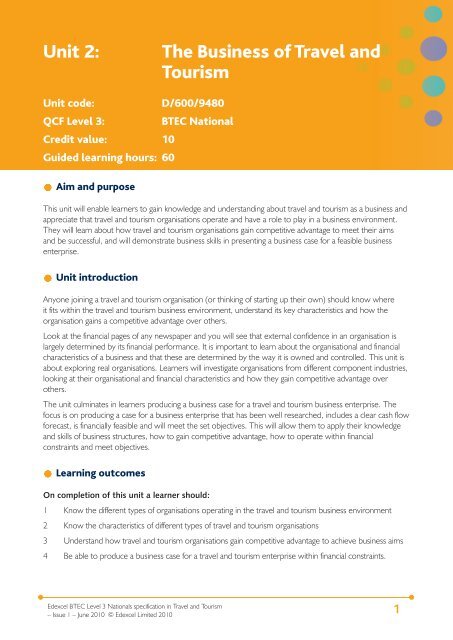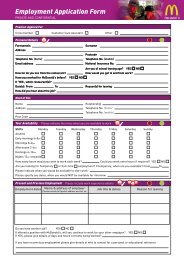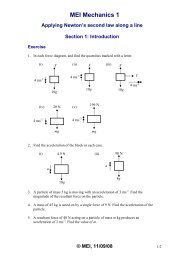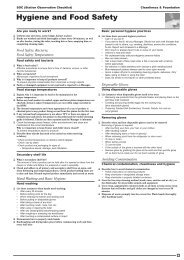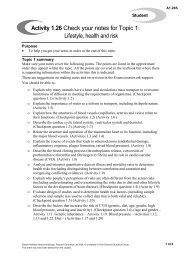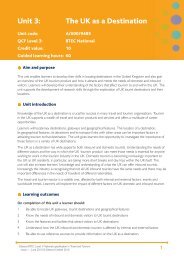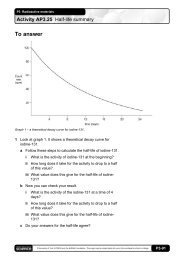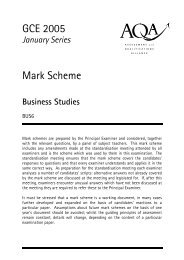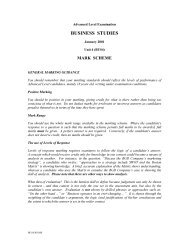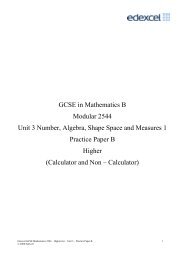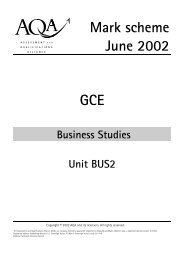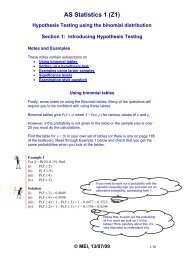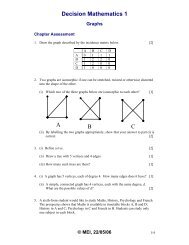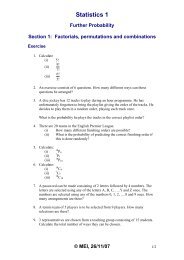Unit 2: The Business of Travel and Tourism
Unit 2: The Business of Travel and Tourism
Unit 2: The Business of Travel and Tourism
You also want an ePaper? Increase the reach of your titles
YUMPU automatically turns print PDFs into web optimized ePapers that Google loves.
<strong>Unit</strong> 2:<strong>The</strong> <strong>Business</strong> <strong>of</strong> <strong>Travel</strong> <strong>and</strong><strong>Tourism</strong><strong>Unit</strong> code:QCF Level 3:Credit value: 10Guided learning hours: 60Aim <strong>and</strong> purposeD/600/9480BTEC NationalThis unit will enable learners to gain knowledge <strong>and</strong> underst<strong>and</strong>ing about travel <strong>and</strong> tourism as a business <strong>and</strong>appreciate that travel <strong>and</strong> tourism organisations operate <strong>and</strong> have a role to play in a business environment.<strong>The</strong>y will learn about how travel <strong>and</strong> tourism organisations gain competitive advantage to meet their aims<strong>and</strong> be successful, <strong>and</strong> will demonstrate business skills in presenting a business case for a feasible businessenterprise.<strong>Unit</strong> introductionAnyone joining a travel <strong>and</strong> tourism organisation (or thinking <strong>of</strong> starting up their own) should know whereit fits within the travel <strong>and</strong> tourism business environment, underst<strong>and</strong> its key characteristics <strong>and</strong> how theorganisation gains a competitive advantage over others.Look at the financial pages <strong>of</strong> any newspaper <strong>and</strong> you will see that external confidence in an organisation islargely determined by its financial performance. It is important to learn about the organisational <strong>and</strong> financialcharacteristics <strong>of</strong> a business <strong>and</strong> that these are determined by the way it is owned <strong>and</strong> controlled. This unit isabout exploring real organisations. Learners will investigate organisations from different component industries,looking at their organisational <strong>and</strong> financial characteristics <strong>and</strong> how they gain competitive advantage overothers.<strong>The</strong> unit culminates in learners producing a business case for a travel <strong>and</strong> tourism business enterprise. <strong>The</strong>focus is on producing a case for a business enterprise that has been well researched, includes a clear cash flowforecast, is financially feasible <strong>and</strong> will meet the set objectives. This will allow them to apply their knowledge<strong>and</strong> skills <strong>of</strong> business structures, how to gain competitive advantage, how to operate within financialconstraints <strong>and</strong> meet objectives.Learning outcomesOn completion <strong>of</strong> this unit a learner should:1 Know the different types <strong>of</strong> organisations operating in the travel <strong>and</strong> tourism business environment2 Know the characteristics <strong>of</strong> different types <strong>of</strong> travel <strong>and</strong> tourism organisations3 Underst<strong>and</strong> how travel <strong>and</strong> tourism organisations gain competitive advantage to achieve business aims4 Be able to produce a business case for a travel <strong>and</strong> tourism enterprise within financial constraints.Edexcel BTEC Level 3 Nationals specification in <strong>Travel</strong> <strong>and</strong> <strong>Tourism</strong>1– Issue 1 – June 2010 © Edexcel Limited 2010
<strong>Unit</strong> content1 Know the different types <strong>of</strong> organisations operating in the travel <strong>and</strong> tourismbusiness environment<strong>Travel</strong> <strong>and</strong> tourism business environment: public sector; private sector; geographical eg local, regional,national, international, global; importance to international <strong>and</strong> UK economy eg GDP, employmentTypes <strong>of</strong> organisations: public sector (government controlled, local government controlled, membership);private sector (public limited company, private limited company, partnership, limited liability partnership,sole proprietor, franchise); inbound; outbound; domestic tourism2 Know the characteristics <strong>of</strong> different types <strong>of</strong> travel <strong>and</strong> tourism organisationsCharacteristic – organisational: business structure eg companies, partnerships, government, members;business organisation eg vertically integrated, horizontally integrated, autonomous; control eg proprietor,board <strong>of</strong> directors, trustees; documentation for business set-up eg certificate <strong>of</strong> incorporation,memor<strong>and</strong>um <strong>of</strong> association, articles <strong>of</strong> association; liability eg to shareholders, to partners, to members,to taxpayersCharacteristics – financial: distribution <strong>of</strong> pr<strong>of</strong>its eg dividends to shareholders, retained pr<strong>of</strong>its/surplus;sources <strong>of</strong> finance eg bank, friends <strong>and</strong> family, shareholders, grants, public funding; to supply products<strong>and</strong> services eg to make a pr<strong>of</strong>it, at cost, to meet a dem<strong>and</strong>, for customers, for other businesses, forgovernment agencies; financial accountability eg to the HM Revenue <strong>and</strong> Customs, to Companies House;contribution to global <strong>and</strong> UK economy eg GDP, employment3 Underst<strong>and</strong> how travel <strong>and</strong> tourism organisations gain competitive advantage toachieve business aimsAims: financial eg to increase revenue, to make a pr<strong>of</strong>it; image eg environmentally friendly, involved inresponsible tourism; products eg improve quality, to meet a dem<strong>and</strong>Gaining competitive advantage: methods <strong>and</strong> opportunities eg providing added value, providing new <strong>and</strong>innovative products <strong>and</strong> services, embedding Total Quality Management, providing excellent customerservice, training <strong>and</strong> developing staff, targeted advertising <strong>and</strong> promotion, innovative pricing policies,locational advantage, modern sales techniques, through integration, through consortium membership4 Be able to produce a business case for a travel <strong>and</strong> tourism enterprise withinfinancial constraints<strong>Business</strong> case: objectives eg to make a pr<strong>of</strong>it, to raise funds, to cover costs; timescales; financial eg funding,costs, revenue; marketing eg strategy, mock-ups; actions requiredFinancial constraints: fixed sum available eg donation, loan, inheritance, public or private fundingEnterprise: eg business venture, charity/fundraising event, pr<strong>of</strong>it-making projectCash flow forecast: cash inflows, eg sales, start-up capital; cash outflows eg payments, raw materials, loanrepayments, overheads, purchase <strong>of</strong> fixed assets; net cash flowFeasibility: the business case is researched <strong>and</strong> realistic <strong>and</strong> will achieve set objectives eg make a pr<strong>of</strong>itwithin given timescales, raise income <strong>and</strong> cover costs, meet a recognised dem<strong>and</strong>, target appropriatemarkets, take account <strong>of</strong> competition, gain competitive advantage, raise money for charity2Edexcel BTEC Level 3 Nationals specification in <strong>Travel</strong> <strong>and</strong> <strong>Tourism</strong>– Issue 1 – June 2010 © Edexcel Limited 2010
Assessment <strong>and</strong> grading criteriaIn order to pass this unit, the evidence that the learner presents for assessment needs to demonstrate thatthey can meet all the learning outcomes for the unit. <strong>The</strong> assessment criteria for a pass grade describe thelevel <strong>of</strong> achievement required to pass this unit.Assessment <strong>and</strong> grading criteriaTo achieve a pass grade theevidence must show that thelearner is able to:P1P2P3P4describe the travel<strong>and</strong> tourism businessenvironment, providingexamples <strong>of</strong> organisationsdescribe the organisational<strong>and</strong> financial characteristics <strong>of</strong>different types <strong>of</strong> travel <strong>and</strong>tourism organisationsreview the methods <strong>and</strong>opportunities used by travel<strong>and</strong> tourism organisations togain competitive advantage<strong>and</strong> achieve business aims,providing examplesproduce a business case for atravel <strong>and</strong> tourism enterprisewithin financial constraints[EP 2, EP 3].To achieve a merit grade theevidence must show that, inaddition to the pass criteria,the learner is able to:M1 compare the organisational<strong>and</strong> financial characteristics<strong>of</strong> two organisations withdifferent business structures,<strong>and</strong> the methods <strong>and</strong>opportunities they have usedto gain competitive advantageM2 present a business case,explaining its feasibility inorder to meet the objectives.To achieve a distinction gradethe evidence must show that,in addition to the pass <strong>and</strong>merit criteria, the learner isable to:D1D2evaluate the links between anorganisation’s characteristics<strong>and</strong> its success in gainingcompetitive advantage <strong>and</strong>achieving its aimspresent a pr<strong>of</strong>essionalbusiness case, respondingconfidently to questions <strong>and</strong>justifying its feasibility.PLTS: This summary references where applicable, in the square brackets, the elements <strong>of</strong> the personal,learning <strong>and</strong> thinking skills applicable in the pass criteria. It identifies opportunities for learners to demonstrateeffective application <strong>of</strong> the referenced elements <strong>of</strong> the skills.KeyIE – independent enquirersRL – reflective learnersSM – self-managersCT – creative thinkersTW – team workersEP – effective participatorsEdexcel BTEC Level 3 Nationals specification in <strong>Travel</strong> <strong>and</strong> <strong>Tourism</strong>– Issue 1 – June 2010 © Edexcel Limited 20103
Essential guidance for tutorsDeliveryLearners should be encouraged to produce a glossary <strong>of</strong> key business terminology encountered throughoutthe unit to aid with learning. Tutors should use discretion when establishing the order <strong>of</strong> delivery for this unitas learners may have already been introduced to the basics <strong>of</strong> this unit in previous work. To identify priorlearning, tutors could produce a quiz where learners are asked questions, in teams, regarding the key areas <strong>of</strong>the unit.Tutors should note that there is an opportunity for learners to link this unit to other units while producing thebusiness plan for the enterprise, eg <strong>Unit</strong> 5: Marketing <strong>Travel</strong> <strong>and</strong> <strong>Tourism</strong> Products <strong>and</strong> Services, <strong>and</strong> <strong>Unit</strong> 17:Events, Conferences <strong>and</strong> Exhibitions.To stimulate discussion, learners could initially look at the travel <strong>and</strong> tourism business environment withintheir local area by identifying the different types <strong>of</strong> travel <strong>and</strong> tourism organisations. For example, a high streettravel agent may be local <strong>and</strong> owned by one person, or a partnership, or a regional limited company, or anational PLC. Learners can identify if organisations are involved with domestic, outbound <strong>and</strong>/or inboundtourism. A discussion about the importance <strong>of</strong> travel <strong>and</strong> tourism to the UK economy could be facilitated <strong>and</strong>learners should be provided with statistics or directed to find relevant data <strong>and</strong> statistics in order to appreciatethe importance not only to the UK economy but worldwide.Learners could be introduced to the organisational <strong>and</strong> financial characteristics <strong>of</strong> different types <strong>of</strong>organisations by using stimulus material such as extracts from newspapers, video clips from televisionprogrammes about companies or selected material from the relevant company websites. Having completedinitial stimulus activities, learners could then work independently to select <strong>and</strong> then describe the organisational<strong>and</strong> financial characteristics <strong>of</strong> two different types <strong>of</strong> travel <strong>and</strong> tourism organisations. It is important that thefocus <strong>of</strong> learners’ investigations is on the organisational <strong>and</strong> financial aspects <strong>of</strong> the organisations as detailedin the content (ie the business structure, business organisation, control, business set up, liability, distribution<strong>of</strong> pr<strong>of</strong>its, sources <strong>of</strong> finance, the overall aim <strong>of</strong> the supply <strong>of</strong> products <strong>and</strong> services, financial accountability<strong>and</strong> contribution to global <strong>and</strong> UK economies). In <strong>Unit</strong> 1 learners have to investigate travel <strong>and</strong> tourismorganisations <strong>and</strong> describe their role in relation to key aims, products <strong>and</strong> services, responsibilities to others,eg stakeholders, <strong>and</strong> contribution to global <strong>and</strong> UK economies. As there is some overlap it is beneficial forthese units to be integrated for learning outcomes l <strong>and</strong> 2 from each unit.To help learners to underst<strong>and</strong> how organisations gain competitive advantage to meet their aims, learnerscould be introduced to the types <strong>of</strong> aims <strong>and</strong> objectives <strong>of</strong> different organisations. This could be throughtutor input, scrutiny <strong>of</strong> textbooks or presentations from one or more guest speakers. Learners could discussmeasures they would propose to meet the aims, perhaps working in small groups to share ideas, <strong>and</strong> thenpresent their findings orally or in a display. Learners could then carry out research into the activities <strong>of</strong> travel<strong>and</strong> tourism organisations through visits, work experience, scrutiny <strong>of</strong> publications such as TTG or <strong>Travel</strong>Weekly or through company websites <strong>and</strong>, where available, company annual reports.4Edexcel BTEC Level 3 Nationals specification in <strong>Travel</strong> <strong>and</strong> <strong>Tourism</strong>– Issue 1 – June 2010 © Edexcel Limited 2010
Learning outcome 4 is practical <strong>and</strong> provides learners the opportunity to be creative, innovative <strong>and</strong>enterprising. As a starting point learners could discuss how to go about organising a day trip for a group.This could be another group <strong>of</strong> students from their college or an outside group, eg a primary school or over60s club. It should not be a trip for their own group as this will not cover the prescribed content. Learnerswill need to underst<strong>and</strong> that they must set objectives, undertake research, produce a plan <strong>of</strong> action <strong>and</strong> aforecast <strong>of</strong> how much it will cost <strong>and</strong> when items will have to be paid, eg the entrance fees, transport, meals<strong>and</strong> accommodation. Learners will need to know if they have funds available, eg from the college/school,work out how much to charge the participants <strong>and</strong> when they should collect the money in order to pay thecosts. At this stage learners should be introduced to simple cash flow forecasts <strong>and</strong>, ideally, practise producingthem for the trip, to include cash inflows <strong>and</strong> cash outflows <strong>and</strong> net cash flow. Learners should be able toappreciate the need to produce a cash flow forecast in order to ensure that there is sufficient cash available topay expenditure at relevant times throughout the period <strong>of</strong> the project. Learners will also need to considerthe advertising <strong>and</strong> promotion <strong>and</strong> their target market with learners creating mock ups <strong>of</strong> their ideas foradvertising <strong>and</strong> promotion. Through this activity learners should recognise the requirements <strong>of</strong> planning fora project <strong>and</strong> this will lead towards developing their knowledge <strong>and</strong> skills in order to put together a businesscase for a travel <strong>and</strong> tourism enterprise. Following this exercise, there should be lots <strong>of</strong> classroom discussionsaround setting up a small business enterprise. For the purposes <strong>of</strong> assessment, the enterprise can be a smallbusiness venture such as a visitor attraction, escorted walking holidays or guest house, or a large-scale projectsuch as organising a three-day tourism exhibition in the local town hall or a charity event.It would be beneficial for learners to examine real business plans <strong>and</strong> practise completing templates <strong>of</strong>business plans <strong>of</strong>ten provided by banks <strong>and</strong> business start-up organisations in business start-up packs to helpthem to build their own business case. It is beneficial to organise a business start-up specialist speaker <strong>and</strong>provide learners with the opportunity to ask questions <strong>and</strong> progress their ideas. Once they have decidedon their business enterprise, subsequent classroom discussions should focus on whether the business caseis feasible in terms <strong>of</strong> achieving set objectives including whether or not it will make a pr<strong>of</strong>it, hitting the targetmarket, gaining competitive advantage.Edexcel BTEC Level 3 Nationals specification in <strong>Travel</strong> <strong>and</strong> <strong>Tourism</strong>– Issue 1 – June 2010 © Edexcel Limited 20105
Outline learning plan<strong>The</strong> outline learning plan has been included in this unit as guidance <strong>and</strong> can be used in conjunction with theprogramme <strong>of</strong> suggested assignments.<strong>The</strong> outline learning plan demonstrates one way <strong>of</strong> planning the delivery <strong>and</strong> assessment <strong>of</strong> this unit.Topic <strong>and</strong> suggested assignments/activities <strong>and</strong> assessmentIntroduction to the unitIdentification <strong>of</strong> the business travel environment through classroom discussion <strong>and</strong> researching travel tradenewspapersClassroom activity to identify the travel <strong>and</strong> tourism business environment through investigating different travel<strong>and</strong> tourism organisations in the local areaIdentifying <strong>and</strong> defining different types <strong>of</strong> travel <strong>and</strong> tourism organisations through class discussion, video clips <strong>and</strong>the travel pressPreparation for assessmentAssignment 1: <strong>The</strong> <strong>Travel</strong> <strong>and</strong> <strong>Tourism</strong> <strong>Business</strong> Environment (P1)Feedback on assessmentClass input on organisational <strong>and</strong> financial characteristics <strong>of</strong> organisationsResearch into different types <strong>of</strong> organisations in preparation for assessmentClass input for competitive advantage: discussion <strong>and</strong> investigationVisits to organisations <strong>and</strong>/or visiting speakers to focus on methods <strong>and</strong> opportunities for gaining competitiveadvantagePreparation for assessmentAssignment 2: Being Successful in <strong>Business</strong> (P2, P3)Feedback on assessmentPreparation for assessmentAssignment 2: Being Successful in <strong>Business</strong> (M1, D1)Feedback on assessmentClass input on business enterprise <strong>and</strong> producing a business case – discussionVisiting speaker from a bank or business start-up advisorDiscussion <strong>and</strong> working in small groups to establish ideas for a business enterpriseResearch <strong>and</strong> investigation into producing a business casePreparation for assessmentAssignment 3: <strong>The</strong> <strong>Business</strong> Case (P4, M2, D2)Feedback on assessment <strong>and</strong> unit review6Edexcel BTEC Level 3 Nationals specification in <strong>Travel</strong> <strong>and</strong> <strong>Tourism</strong>– Issue 1 – June 2010 © Edexcel Limited 2010
AssessmentA variety <strong>of</strong> assessment methods could be used, including presentations, practical activities <strong>and</strong> displays, aswell as the more formal written assignment approach. It is recommended that more than one method is usedto cater for the different learning styles within a group.<strong>The</strong> assessment criteria shown in the assessment <strong>and</strong> grading grid can be grouped together to enable learnersto exp<strong>and</strong> on one criterion in order to gain higher grades. <strong>The</strong> links are as follows: P1, P2, P3, M1 <strong>and</strong> D1;P4, M2 <strong>and</strong> D1; Where possible, learners should be encouraged <strong>and</strong> given the opportunity to meet therelevant higher grading opportunities at the same time as they attempt the appropriate pass criteria.Group activities may lend themselves to certain themes or assessments but it is essential that all learners keepa portfolio <strong>of</strong> their own work <strong>and</strong> have evidence <strong>of</strong> individually covering all the criteria for which they arecredited.P1 – P2 – P3 – M1 – D1For P1, learners should describe the travel <strong>and</strong> tourism business environment by providing a short description<strong>of</strong> each item <strong>of</strong> range as follows: public sector; private sector; geographical, eg local, regional, national,international, global; importance to international <strong>and</strong> UK economy, eg GDP, employment. For each type <strong>of</strong>organisation listed in the content, including those in the brackets, learners should provide an example togetherwith a brief description. An example would be: North West <strong>Travel</strong> is a small local coach operator situated inBlackburn; they operate day trips <strong>and</strong> coach tours to most parts <strong>of</strong> the UK. <strong>The</strong>y are in the private sector <strong>and</strong>are set up as a private limited company. <strong>The</strong>y are involved in domestic tourism.For P2, learners should describe the organisational <strong>and</strong> financial characteristics <strong>of</strong> two different types <strong>of</strong> travel<strong>and</strong> tourism organisations with different structures. For example, they could select a medium national privatelimited company involved in outbound tourism <strong>and</strong> a local partnership involved in domestic tourism. All items<strong>of</strong> range must be included in the description. If the two organisations selected do not <strong>of</strong>fer the opportunity tocover all the items <strong>of</strong> range, these items can be covered through other organisations.For P3, learners should review the methods <strong>and</strong> opportunities used to gain competitive advantage <strong>and</strong>achieve aims by different types <strong>of</strong> travel <strong>and</strong> tourism organisations <strong>and</strong> provide examples to cover all types <strong>of</strong>aims, ie financial, image, products. Learners can use the same organisations as for P2 or other organisationsin the sector to ensure full coverage <strong>of</strong> range. <strong>The</strong> examples provided must be sufficiently detailed todemonstrate that the learner underst<strong>and</strong>s how the method or opportunity has achieved the aim. Forexample, provide details about how an independent travel agent has used advertising to promote its imageas being an agent that can put together a customised holiday because they have more expertise than themultiple agent – ‘book with the experts for tailor made holidays designed to suit your needs’.M1 progresses from P2 <strong>and</strong> P3 <strong>and</strong> learners should compare the financial <strong>and</strong> organisational characteristics<strong>of</strong> two travel <strong>and</strong> tourism organisations that have different business structures, eg companies, partnerships,government controlled, memberships. Learners should then compare the methods <strong>and</strong> opportunities theyhave used to gain competitive advantage to achieve aims. <strong>The</strong> two organisations selected for P2 <strong>and</strong> P3 canbe used <strong>and</strong> it is expected that all items <strong>of</strong> range as listed for P2 <strong>and</strong> P3 will be covered in the comparison.For D1, learners must demonstrate that they are able to evaluate links between the organisational <strong>and</strong>financial characteristics <strong>of</strong> an organisation <strong>and</strong> how this has helped the organisation to be successful in gainingcompetitive advantage to achieve their aims. For example, a small independent travel agent has become part<strong>of</strong> a consortium in order to compete with those agencies owned by large international integrated PLCs. Aspart <strong>of</strong> a consortium they can <strong>of</strong>fer better commission levels <strong>and</strong> better deals to customers <strong>and</strong> so increaserevenue. A large international tour operator, a PLC, aims to present an image <strong>of</strong> being a responsible touroperator with an awareness <strong>of</strong> the need to be environmentally friendly. <strong>The</strong> tour operator, because it isa PLC, has the capacity to launch a focused advertising <strong>and</strong> promotional campaign to raise its image <strong>and</strong>specifically train <strong>and</strong> develop its staff to promote the image. Learners should provide examples to cover allthree types <strong>of</strong> aim, ie financial, image <strong>and</strong> products. Learners can use the organisations covered in P2 <strong>and</strong> P3Edexcel BTEC Level 3 Nationals specification in <strong>Travel</strong> <strong>and</strong> <strong>Tourism</strong>– Issue 1 – June 2010 © Edexcel Limited 20107
or other organisations in order to fully cover the range. <strong>The</strong> evaluation must be in depth <strong>and</strong> demonstrate athorough underst<strong>and</strong>ing <strong>of</strong> the characteristics <strong>and</strong> the methods <strong>and</strong> opportunities utilised to be successful intoday’s travel <strong>and</strong> tourism business environment.P4 – M2 – D2To achieve P4, learners are required to produce a business case for a travel <strong>and</strong> tourism business enterprisewithin financial constraints. <strong>The</strong> enterprise should be a small business venture, eg a visitor attraction,escorted walking holidays or guest house, or it could be a large-scale project such as organising a three-daytourism exhibition in the local town hall or a charity event. <strong>The</strong> financial constraints can be set as part <strong>of</strong> theassignment by the tutor or left to the learners to state the finances available for the enterprise. Learners arenot expected to run the project; they are expected to put together a business case to gain approval to runthe project or small business venture <strong>and</strong> to present the business case to an accountant or financial advisorin order to judge its feasibility. Learners must set their objectives <strong>and</strong> undertake thorough research for allaspects <strong>of</strong> the enterprise. Full details must be included in the business case, together with a cash flow forecast,details <strong>of</strong> intended marketing materials <strong>and</strong> clear timescales for the setting up <strong>and</strong> operation <strong>of</strong> the enterprise.Learners must produce a business case that is feasible, ie researched <strong>and</strong> realistic <strong>and</strong> achieve set objectives,eg make a pr<strong>of</strong>it within given timescales, raise income <strong>and</strong> cover costs, meet a recognised dem<strong>and</strong>, targetappropriate markets, take account <strong>of</strong> competition, gain competitive advantage. <strong>The</strong> business case could bepresented verbally with supporting evidence or in a written format. If presented verbally, it could be to a panel<strong>of</strong> business start-up experts, the panel being made up <strong>of</strong> external experts <strong>and</strong> tutors. Learners can achieve P4even if the business case has room for improvement as long as the evidence includes objectives, timescales,financial <strong>and</strong> marketing details, a list <strong>of</strong> actions required, is within the specified financial constraints, has a cashflow forecast <strong>and</strong> is feasible.To achieve M2, learners should explain the feasibility <strong>of</strong> the business case <strong>and</strong> justify how it will meet theobjectives. Assessors can question learners to establish feasibility <strong>and</strong> check underst<strong>and</strong>ing in relation totimescales, financial feasibility <strong>and</strong> actions required in order to meet objectives. To achieve M2, the businesscase should be sound <strong>and</strong> the learners reasonably confident in their approach <strong>and</strong> their responses.To achieve D2, learners should present a pr<strong>of</strong>essional business case responding confidently to questions<strong>and</strong> justifying its feasibility. It is expected that the business case will have been thoroughly researched,presented in a pr<strong>of</strong>essional format (written) or within a pr<strong>of</strong>essional presentation (oral) <strong>and</strong> with supportingmaterials to clarify <strong>and</strong> exp<strong>and</strong> on the details within the business case. Learners will respond confidently <strong>and</strong>knowledgeably to questions <strong>and</strong> be able to justify why their business case is feasible in terms <strong>of</strong> it being wellresearched, realistic <strong>and</strong> that it will meet its objectives. To achieve D1, there should be no areas <strong>of</strong> weakness.It is expected that the learner will present their business case to a panel including their tutor <strong>and</strong> wherepossible an external member.8Edexcel BTEC Level 3 Nationals specification in <strong>Travel</strong> <strong>and</strong> <strong>Tourism</strong>– Issue 1 – June 2010 © Edexcel Limited 2010
Programme <strong>of</strong> suggested assignments<strong>The</strong> table below shows a programme <strong>of</strong> suggested assignments that cover the pass, merit <strong>and</strong> distinctioncriteria in the grading grid. This is for guidance <strong>and</strong> it is recommended that centres either write their ownassignments or adapt any Edexcel assignments to meet local needs <strong>and</strong> resources.Criteria covered Assignment title Scenario Assessment methodP1Assignment 1: <strong>The</strong> <strong>Travel</strong><strong>and</strong> <strong>Tourism</strong> <strong>Business</strong>EnvironmentWorking for a travel <strong>and</strong>tourism organisation <strong>and</strong>giving a talk to local sixform college studentsPresentation <strong>and</strong>information sheets/postersP2, P3M1, D1Assignment 2: BeingSuccessful in <strong>Business</strong>Working for a travel <strong>and</strong>tourism organisation <strong>and</strong>giving a talk to local sixform college studentsResearch producinginformation packs onorganisationsPresentation withopportunities for Q <strong>and</strong> A.P4Assignment 3: <strong>The</strong><strong>Business</strong> CaseSetting up own businessenterpriseProducing a business casein written or verbal formatM2, D2Presenting the businesscase to a panel <strong>of</strong> businessstart-up expertsLinks to National Occupational St<strong>and</strong>ards, other BTEC units, other BTECqualifications <strong>and</strong> other relevant units <strong>and</strong> qualificationsThis unit forms part <strong>of</strong> the BTEC travel <strong>and</strong> tourism sector suite. This unit has particular links with:Level 2 Level 3Exploring Marketing in <strong>Travel</strong> <strong>and</strong> <strong>Tourism</strong>Developing Employability Skills for <strong>Travel</strong> <strong>and</strong> <strong>Tourism</strong>Organising a Study VisitInvestigating the <strong>Travel</strong> <strong>and</strong> <strong>Tourism</strong> SectorMarketing <strong>Travel</strong> <strong>and</strong> <strong>Tourism</strong> Products <strong>and</strong> ServicesEvents, Conferences <strong>and</strong> ExhibitionsEssential resourcesFor this unit learners need access to the internet <strong>and</strong> access to published material such as the travel tradepress, newspapers <strong>and</strong> textbooks.Employer engagement <strong>and</strong> vocational contextsLearners should explore their local area <strong>and</strong> visit a variety <strong>of</strong> different organisations in order to underst<strong>and</strong>the travel <strong>and</strong> tourism business environment. Group visits to travel <strong>and</strong> tourism organisations or visitingspeakers from travel <strong>and</strong> tourism organisations would be beneficial to assist investigations into organisational<strong>and</strong> financial characteristics <strong>and</strong> how organisations gain competitive advantage <strong>and</strong> achieve their aims. Forlearning outcome 4, learners should be encouraged to talk to local business people who have set up travel<strong>and</strong> tourism enterprises in their local area. Links with business start-up organisations <strong>and</strong> banks would also be<strong>of</strong> benefit.Edexcel BTEC Level 3 Nationals specification in <strong>Travel</strong> <strong>and</strong> <strong>Tourism</strong>– Issue 1 – June 2010 © Edexcel Limited 20109
Indicative reading for learnersTextbooksDale G – BTEC Level 3 National <strong>Travel</strong> <strong>and</strong> <strong>Tourism</strong> Student Book 1 (Pearson, 2010) ISBN 9781846907272Dale G – BTEC Level 3 National <strong>Travel</strong> <strong>and</strong> <strong>Tourism</strong> Student Book 2 (Pearson, 2010) ISBN9781846907289Dale G, Kelly M, King C <strong>and</strong> Jefferies M – BTEC Level 3 National <strong>Travel</strong> <strong>and</strong> <strong>Tourism</strong> Teaching Resource Pack(Pearson, 2010) ISBN 9781846907296Holloway C – <strong>The</strong> <strong>Business</strong> <strong>of</strong> <strong>Tourism</strong>, Seventh Edition (FT Prentice Hall, 2006) ISBN 0273701614James E, Thirlaway J <strong>and</strong> Woodhouse U – BTEC National in <strong>Travel</strong> <strong>and</strong> <strong>Tourism</strong> (Hodder Education, 2007)ISBN 9780340945735Journals<strong>Travel</strong> Trade Gazette<strong>Travel</strong> WeeklyWebsitesSee <strong>Unit</strong> 1 for suggested websites for travel <strong>and</strong> tourism organisations.Useful websites for learning outcome 4:www.businesslink.gov.ukwww.smallbusiness.co.ukwww.startups.co.uk10Edexcel BTEC Level 3 Nationals specification in <strong>Travel</strong> <strong>and</strong> <strong>Tourism</strong>– Issue 1 – June 2010 © Edexcel Limited 2010
Delivery <strong>of</strong> personal, learning <strong>and</strong> thinking skills (PLTS)<strong>The</strong> table below identifies the opportunities for personal, learning <strong>and</strong> thinking skills (PLTS) that have beenincluded within the pass assessment criteria <strong>of</strong> this unit.SkillEffective participatorsWhen learners are …producing a business case for a travel <strong>and</strong> tourism enterprise within financialconstraints [EP 2, EP 3]Although PLTS are identified within this unit as an inherent part <strong>of</strong> the assessment criteria, there are furtheropportunities to develop a range <strong>of</strong> PLTS through various approaches to teaching <strong>and</strong> learning.SkillSelf-managersWhen learners are …managing the assessment <strong>of</strong> the unitEdexcel BTEC Level 3 Nationals specification in <strong>Travel</strong> <strong>and</strong> <strong>Tourism</strong>– Issue 1 – June 2010 © Edexcel Limited 201011
Functional Skills — Level 2SkillICT — Use ICT systemsSelect, interact with <strong>and</strong> use ICT systemsindependently for a complex task to meet avariety <strong>of</strong> needsUse ICT to effectively plan work <strong>and</strong>evaluate the effectiveness <strong>of</strong> the ICT systemthey have usedManage information storage to enableefficient retrievalFollow <strong>and</strong> underst<strong>and</strong> the need for safety<strong>and</strong> security practicesTroubleshootICT — Find <strong>and</strong> select informationSelect <strong>and</strong> use a variety <strong>of</strong> sources <strong>of</strong>information independently for a complex taskAccess, search for, select <strong>and</strong> use ICTbasedinformation <strong>and</strong> evaluate its fitness forpurposeICT — Develop, present <strong>and</strong>communicate informationEnter, develop <strong>and</strong> format informationindependently to suit its meaning <strong>and</strong>purpose including:●●●●text <strong>and</strong> tablesimagesnumbersrecords.Bring together information to suit content<strong>and</strong> purposePresent information in ways that are fit forpurpose <strong>and</strong> audienceSelect <strong>and</strong> use ICT to communicate <strong>and</strong>exchange information safely, responsibly <strong>and</strong>effectively including storage <strong>of</strong> messages <strong>and</strong>contact listsMathematicsUnderst<strong>and</strong> routine <strong>and</strong> non-routineproblems in a wide range <strong>of</strong> familiar <strong>and</strong>unfamiliar contexts <strong>and</strong> situationsIdentify the situation or problem <strong>and</strong> themathematical methods needed to tackle itSelect <strong>and</strong> apply a range <strong>of</strong> skills to findsolutionsWhen learners are …researching the travel <strong>and</strong> tourism business environment <strong>and</strong>examples <strong>of</strong> organisationsplanning the assignmentsresearching the travel <strong>and</strong> tourism business environment <strong>and</strong>examples <strong>of</strong> organisationsongoingas requiredresearching the travel <strong>and</strong> tourism business environment <strong>and</strong>examples <strong>of</strong> organisationsresearching the travel <strong>and</strong> tourism business environment <strong>and</strong>examples <strong>of</strong> organisationsrecording the travel <strong>and</strong> tourism business environment <strong>and</strong>examples <strong>of</strong> organisationsrecording the travel <strong>and</strong> tourism business environment <strong>and</strong>examples <strong>of</strong> organisationsrecording the travel <strong>and</strong> tourism business environment <strong>and</strong>examples <strong>of</strong> organisationssharing information about the travel <strong>and</strong> tourism businessenvironment <strong>and</strong> examples <strong>of</strong> organisationsproducing a business case for a travel <strong>and</strong> tourism enterprisewithin financial constraintsproducing a business case for a travel <strong>and</strong> tourism enterprisewithin financial constraintsproducing a business case for a travel <strong>and</strong> tourism enterprisewithin financial constraints12Edexcel BTEC Level 3 Nationals specification in <strong>Travel</strong> <strong>and</strong> <strong>Tourism</strong>– Issue 1 – June 2010 © Edexcel Limited 2010
SkillUse appropriate checking procedures <strong>and</strong>evaluate their effectiveness at each stageInterpret <strong>and</strong> communicate solutions topractical problems in familiar <strong>and</strong> unfamiliarroutine contexts <strong>and</strong> situationsDraw conclusions <strong>and</strong> provide mathematicaljustificationsEnglishSpeaking <strong>and</strong> listening – make a range <strong>of</strong>contributions to discussions <strong>and</strong> makeeffective presentations in a wide range <strong>of</strong>contextsReading – compare, select, read <strong>and</strong>underst<strong>and</strong> texts <strong>and</strong> use them to gatherinformation, ideas, arguments <strong>and</strong> opinionsWriting – write documents, includingextended writing pieces, communicatinginformation, ideas <strong>and</strong> opinions effectively<strong>and</strong> persuasivelyWhen learners are …producing a business case for a travel <strong>and</strong> tourism enterprisewithin financial constraintsproducing a business case for a travel <strong>and</strong> tourism enterprisewithin financial constraintsproducing a business case for a travel <strong>and</strong> tourism enterprisewithin financial constraintsdiscussing the organisational <strong>and</strong> financial characteristics <strong>of</strong>different types <strong>of</strong> travel <strong>and</strong> tourism organisationsresearching the organisational <strong>and</strong> financial characteristics <strong>of</strong>different types <strong>of</strong> travel <strong>and</strong> tourism organisationsdescribing the organisational <strong>and</strong> financial characteristics <strong>of</strong>different types <strong>of</strong> travel <strong>and</strong> tourism organisationsEdexcel BTEC Level 3 Nationals specification in <strong>Travel</strong> <strong>and</strong> <strong>Tourism</strong>– Issue 1 – June 2010 © Edexcel Limited 201013


